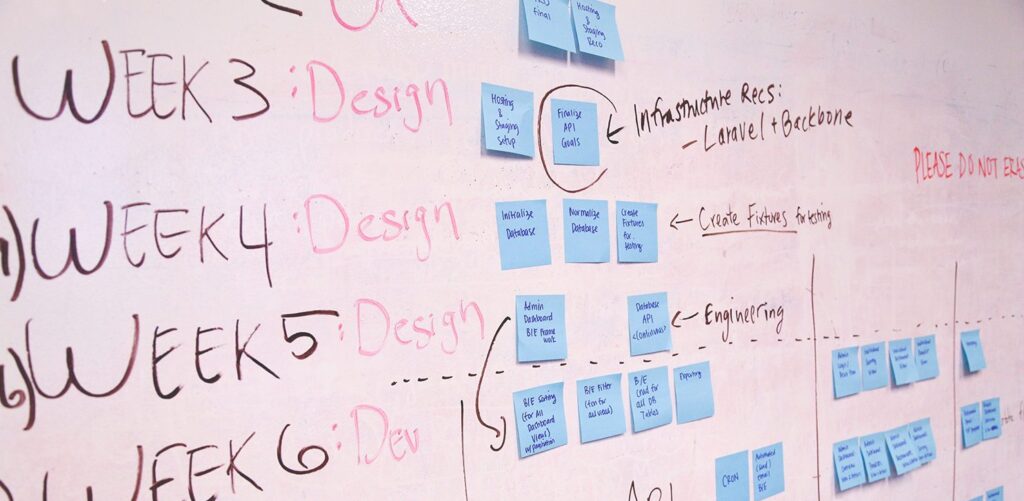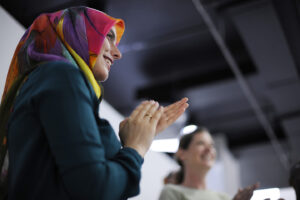
Marketing
I know, I know…it sounds too good to be true. And, your mother always told you if something sounds too good to be true, then it probably is. And, I would normally agree with her on this (and almost anything else because MOMS ROCK!) But not this time. She’s wrong (sorry, Mom). You CAN hire an entire marketing team for less than the cost of a single employee. How?
Hire a Marketing Agency.
The numbers will never justify an employee over an agency, and here’s why…

According to Salary.com, the average annual salary for a marketing manager in the Detroit metro area (near where the agency I work for – full disclosure – is located) is $104,164. That’s about $8,680 per month. For that amount, you can put a marketing agency on retainer. “But,” you say, “that is the SAME cost, not less.”
That’s true…but it’s not.
The $8,680 a month you pay the marketing agency is the “all-in” price. For your employee, you still have to figure in the cost of (among other things):
• Payroll taxes
• Benefits
• Hiring/Onboarding/Training
• Software
• General overhead like rent (for their desk space), air conditioning (for their comfort) and paperclips (for their papers …and “art sculptures”)
Looking at all the additional expenses on top of a base salary makes it easy to see how it actually costs LESS to hire an agency. “But,” you insist, “my marketing employee is still dedicated to me alone, and the agency won’t be.”
You’re right, and that’s good…but it’s bad.
Because marketing workloads fluctuate wildly and often, your marketing staffing needs do too.
 Having a full-time, dedicated employee means you need to provide them with full-time, dedicated work. Many small to mid-size businesses don’t always have enough marketing work for a full-time employee. More likely, however, they have marketing work that requires a full-time effort for a while, then can slow way down or stop altogether before picking back up to full-time…for a while. (You see where I’m going here, right?)
Having a full-time, dedicated employee means you need to provide them with full-time, dedicated work. Many small to mid-size businesses don’t always have enough marketing work for a full-time employee. More likely, however, they have marketing work that requires a full-time effort for a while, then can slow way down or stop altogether before picking back up to full-time…for a while. (You see where I’m going here, right?)
Because agencies work for multiple clients, they can work with your fluctuating workloads. They can assign your work the resources it needs when you need them. And, they can reassign them to another client’s work when you don’t. The best part is that you usually only pay for the time they work on your projects. So, you are paying only for the time you use.
“That’s ridiculous,” you say, “I run a small business, and I have plenty of marketing projects for a full-time employee. I would rather have ‘my marketing gal’ (or guy!), ready to do it all.”
And, that’s a really great idea…for a bad idea.
The bottom line is that no one can do it all – especially when it comes to marketing.
 Most businesses today require a mix of marketing skills to be successful. Graphic design, writing, web design, web programming, social media, and public relations are all skills that will probably, from time-to-time, be needed to effectively market your business.
Most businesses today require a mix of marketing skills to be successful. Graphic design, writing, web design, web programming, social media, and public relations are all skills that will probably, from time-to-time, be needed to effectively market your business.
And, with the speed at which technologies, software, methodologies, and best practices are changing in all of these areas, it is impossible for one person to possess all those skills and maintain them to the level necessary for your business to use them effectively.
When you work with an agency, you have a team of specialists and subject matter experts at the ready—each with specific expertise in one or two areas of marketing. This exponentially increases your access to QUALITY knowledge and resources to grow your business.
To be fair, not all agencies have staff who specialize in every area of marketing. But, they do have relationships with a stable of freelancers and partnerships with specialty agencies (like videography or web design companies) that they can call on as needed. So, with an agency, you’re always covered with top-notch resources.
“All of this sounds great,” you’re now thinking, “but working with an agency just isn’t right for me and my business.”
And that may be true…but it’s most likely false.
There is a marketing agency out there that is the right fit for every business.
 OK. I’m going to say this just once so listen up: You may be better off hiring a marketing employee than you are if you hire a marketing agency. Your business is YOUR business. And, you may be one of those people who likes to do certain things in very specific ways…like your marketing. I can relate. I’m like that. So, if you are dead-set on hiring a marketing staff member. Go for it.
OK. I’m going to say this just once so listen up: You may be better off hiring a marketing employee than you are if you hire a marketing agency. Your business is YOUR business. And, you may be one of those people who likes to do certain things in very specific ways…like your marketing. I can relate. I’m like that. So, if you are dead-set on hiring a marketing staff member. Go for it.
But, marketing agencies come in all shapes and sizes, and I guarantee you there is one out there for you when you are ready.
For instance, many agencies work only with clients in one or a few industries. Other agencies work with companies of a certain size or within a certain geographic area. And, there are agencies of all sizes – from a few to hundreds of employees. Plus, you can find agencies that work with every size marketing budget and project workload.
But the one thing that is the same with any agencies is that they measure their success by your success. Any agency worth its salt wants to find and retain only those clients who are going to succeed by working with them. And, if—or when—that is not true, they part ways amicably, and will even help you find an agency that is a better fit.
I know what you’re thinking now — “I need to hire a marketing agency!”
And you are right. Absolutely right.

Marketing, Networking
 Familiarization tours, more commonly known as “FAM Tours,” are a fantastic tool for bringing out of town investors, agencies, or consultants to your area. Often initiated by economic developers, FAM Tours provide your guests with the perfect opportunity to experience all your community has to offer.
Familiarization tours, more commonly known as “FAM Tours,” are a fantastic tool for bringing out of town investors, agencies, or consultants to your area. Often initiated by economic developers, FAM Tours provide your guests with the perfect opportunity to experience all your community has to offer.
Regardless of your role in the process, you want to assure that everything runs smoothly for both the hosts and guests. Whether you are hosting the event directly or for a client, you all have the same goal—make your guests want to come back. There’s nothing worse than flying across the country to find a room full of people hectically deciding on a schedule. Weekend: ruined.
The Difference Makers
Let the experiences speak for themselves. Your guests need time to let everything sink in. They are experiencing things for the first time. Don’t ruin it by treating your event like a business meeting.
 Give them something tangible to remember you by. Often, hosts will provide their guests with gift bags containing local goodies they can only get from the area they’re visiting. Hosting in Wisconsin? Give them a delicious cheese sampler that they can’t get anywhere else.
Give them something tangible to remember you by. Often, hosts will provide their guests with gift bags containing local goodies they can only get from the area they’re visiting. Hosting in Wisconsin? Give them a delicious cheese sampler that they can’t get anywhere else.
Local is good, but local and unique is better. Yeah, Applebee’s might be an American treasure, but I can personally guarantee that you will be able to find somewhere local and unique for your guests to eat.
Don’t wait until they arrive to start building relationships. If you want your tour to be a success, start understanding who they are and what they like before they arrive. It will make for great conversation and easier event planning.
FAM Tours are not reality TV shows. Social media posts are a perfect way to market your tour, but bombarding your guests with pictures and questions will make them feel constricted.
Don’t be afraid to show them a good time. No one said you aren’t allowed to let your hairdown and have fun with your guests. All work and no play makes for a disappointing visit.
Every guest is their own person. Everyone enjoys doing different things, so mix it up a bit and show some variety throughout your itinerary.
Bring in some outsiders. While your tour should be both fun and educational, it’s always good to bring in some individuals outside of the business realm. Try inviting people who are thought leaders of community development projects, not just people who are trying to sell something.
Properly marketing your tour is essential for maximum attendance and, of course, good publicity. From save-the-dates and invitations, to booking flights and reservations, everything needs to be packaged perfectly. My recommendation? Collaborate with a marketing agency. Simple might do the trick for some, but strategy, creativity, and organization will make your event stand out from the rest.

Branding, Marketing, Public Relations, Strategy

Is it just me, or has the world of marketing been going a little too well over the past few weeks? It seems as though there was a faint ticking sound coming from the marketing campaign time bomb, just waiting to blow.
Since the unfortunate airing of the Kendall Jenner Pepsi commercial or the United Airlines passenger mishap, there really hasn’t been any exciting marketing and PR news. Well, that all changed last week when Bedrock Detroit decided to launch its “See Detroit Like We Do” campaign. I wouldn’t necessarily say I’m pleased that another campaign finally fell through the cracks, but you must agree that it was long overdue.

For those of you who haven’t seen it yet, Bedrock Detroit placed a sign with the slogan “See Detroit Like We Do,” that filled the windows along the ground level of a building in downtown Detroit. That doesn’t sound too bad, right? Wrong. The photograph featured mostly white individuals in a city that is widely known for its diverse culture.
Yikes! Now What?
How companies handle unfortunate situations like the Bedrock Campaign is crucial for their ongoing success. Luckily, Dan Gilbert, founder of Bedrock Detroit and Quicken Loans, was able to address the situation with both speed and grace. “We screwed up badly the graphic package that was partially installed on the retail windows of the first floor of the Vinton Building, in downtown Detroit,” Gilbert said in an open letter posted on Bedrock Detroit’s Facebook page.

“Although not intended to create the kind of feelings it did, the slogan/statement we used on these graphics was tone deaf, in poor taste and does not reflect a single value or philosophy that we stand for at Bedrock Development or in our entire Family of companies,” the letter said. “We have killed the ‘See Detroit Like We Do’ campaign.” It looks like someone payed attention in public relations class! Bravo, Dan.
So, What Did We Learn?
The mistakes that companies make can be very detrimental to both their finances and public image. This is where the PR department must weigh its options; to act or not to act—that is the question.
- Act. And act quickly. When bad news hits you directly, you need to respond immediately.
- Give your organization a face. At this point you’re already dealing with bad publicity, so you want to present your company as one which people can connect with.
- Present the facts. Considering the media driven world we live in, many situations become twisted and can make your situation out to be worse than it is, so act truthfully.
- Be transparent. Allowing people to see how and why things went wrong can help your image in the future.
- Own up to your mistakes. Aside from acting quickly, this might be the most important step. People don’t want to hear the run-around of excuses. Admit your faults and move on.
- Be sincere. Most people can cut through a lot of business talk and empty words. If they can hear sincerity, they are more likely to be forgiving.
While it is somewhat unsettling to see our fellow marketers make these mistakes, it’s an eye-opening experience for anyone involved—particularly the audience. Put yourself in their shoes; see your message through their eyes. You don’t want to be the one to set off that ticking time bomb.
Branding, Communication, Marketing, Strategy
Have you noticed an uptick in messages about self-love and acceptance these days? You know, the messages encouraging you to embrace who you are and what makes you different; to really own it. It’s a nice way of saying quit trying to be someone you’re not! In marketing, as we continue to work on personifying brands, it’s not a stretch to carry over that mentality.
Are you owning your brand or struggling in the identity department? Let’s do a little self-diagnosis.
Here are three signs you have a brand identity problem:
Your answer to “What do you stand for?” changes depending on who is asking.
You make marketing decisions based on what’s trendy rather than brand strategy.
You have a lukewarm relationship with your target audience.
If any of these questions strike a chord, it’s time to go back to basics with your brand. It’s not an insult or a sign of weakness; major brands regularly revisit their strategy to evaluate and adjust for maximum effect. This will get you back on track and ahead of those who are too proud to admit they have a problem.
There are many more elements to building up a wow factor, but these are the ingredients for a strong foundation.
Brands, like people, grow and develop over time. They need constant assessment to understand what they stand for over the years or else they will become outdated and unrelatable.
- Be sure of your values and target audience, and be mindful of just how those two things overlap.
- Understand the needs of your audience and how they wish to be reached.
- Present yourself consistently in terms of messaging and frequency.
Make your Marque
What happens when you get to the point where you own your brand? You aren’t hiding behind anything and you aren’t trying to imitate others. You are no longer worried about pleasing every person on the planet, because you know that is just not going to happen. (Really, it’s not.) Instead, you know that by owning your brand, you’ll attract people that value what you value.
Communication, Marketing, Networking
 When freshly graduated college students leave their campus nests, they often have the desire to spread their wings and move to a big city such as New York or Los Angeles. Their “take over the world” mentality is inspiring to say the least, but could be arguably more effective when implemented in a smaller area.
When freshly graduated college students leave their campus nests, they often have the desire to spread their wings and move to a big city such as New York or Los Angeles. Their “take over the world” mentality is inspiring to say the least, but could be arguably more effective when implemented in a smaller area.
The cities with a little less glam (and a lot less traffic) are increasing their share of these valuable college grads at a much higher rate than the New Yorks of the world, ultimately creating a desirable working environment.
Draw What You See, Write What You Know
 Contrary to what some people believe, working in the area that you grew up in or studied in can be extremely beneficial. Knowing the strengths and weaknesses of your region is a major advantage when entering the workforce.
Contrary to what some people believe, working in the area that you grew up in or studied in can be extremely beneficial. Knowing the strengths and weaknesses of your region is a major advantage when entering the workforce.
There are plenty of unique opportunities that might not be as obvious to those accustomed to the anonymity of a big city. Specifically, in a smaller city, it’s often easier to create meaningful connections with other businesses and higher-ups.
Whether you are familiar with the industries in your area or not, it is crucial to know who you’re working with and who you’re up against. Familiarizing yourself with other businesses provides you with the opportunity to learn from what others do. This helps with the implementation of new ideas into your company’s strategy.
Success in an industry often comes down to who you know, and the tighter-knit communities allow for those successes to happen at a faster pace.
Live, Work, Play – Lenawee County
Lenawee County, while significantly smaller than New York, is known for its great educational opportunities, natural beauty, and diverse communities. Though it might be a cliché, it truly is a great place to live, work, and play.
The four exceptional post-secondary schools housed in Lenawee County allow for businesses to pull from the best of the best. As graduates leave their nests they take their knowledge and directly apply it to their career. Regardless of the time spent at these institutions, students have established networks that are bursting at the seams with potential.
Hoyden, Why Adrian?
Starting a business in Adrian was a no-brainer for cofounders Sarah Stanley and Molly Mason. Aside from being the only marketing and design agency in the area, the constant support for entrepreneurs from community members, municipality leaders, and other business owners is like no other. CEO, Sarah Stanley, had this to say, “Adrian is a small town eager to do big things. Knowing the attitude toward entrepreneurship, attracting young professionals, and filling gaps in service offerings just reassured our decision to locate here. We have received tremendous support and encouragement that have helped build the foundation of our business and are excited to be coming in at the time of Downtown Adrian’s revitalization effort. Adrian is home for us.”
Due to its recent development, more and more young professionals are moving to Adrian to begin their career. Creative Director, Alex Bourget, relocated from Washtenaw County to pursue her skills as a graphic designer for HCG and couldn’t be happier. “Working in Adrian has allowed me to become more involved with the community and local government. I feel as though I am able to get more accomplished here than I have anywhere else.”
The city’s leaders are dedicated to helping new businesses get started and flourish, and fellow businesses treat your growth as though it’s their own. Quite simply, Adrian provides a plethora of resources, talent, opportunities, and community involvement; the perfect recipe for a successful business.
Branding, Marketing, Strategy

The definition of the term “brand” or “branding” has been debated on for many years. What began as a company name, slogan, and logo has become a complex marketing strategy that defines who you are and what your company represents. Good branding increases the overall value of a company, provides direction, and makes working with other businesses easier. So, what’s stopping you?
IDENTIFYING A BRAND
Deciding on the direction of your brand can be intimidating and very time consuming. It is easy to get stuck on a specific idea for your brand that might not be the best option. This is when it’s beneficial to step back and look at your company from a consumer’s standpoint. Consumers decide whether your brand is worth remembering, so their opinion is key in the development process.
- Identify your positioning.
- Establish company values.
- Determine target audience.
- Where do all of these develop? That is your brand.
CREATING A BRAND BOARD
Putting together a brand board for your company is arguably one of the best ways to develop a visual brand. Brand boards allow you to lay out all aspects of your company so that they are accessible to your employees. They also serve as a reference point when working with other companies, ultimately ensuring consistency and error-free work. Sometimes when something is laid out, it is easier to see elements that don’t belong, or cause friction instead of harmony.
 When designing a basic brand board, we are always sure to include:
When designing a basic brand board, we are always sure to include:
- Logos & Tagline – Including all renditions and how to properly apply them.
- Colors & Elements – Including Pantone colors if applicable, and any design elements like patterns, textures, or other visual motifs.
- Fonts – Including body, title, and accent text.
- Photography – Including photos that are regularly used, providing a few examples of the style and mood to help with maintaining consistency.
IF YOU’VE GOT IT, FLAUNT IT
Once you’ve developed a brand, it is important to get people talking about it. People love to tell their friends about the brands they like, but they can’t tell someone about a brand they can’t remember. That said, do you ever wonder how companies show up out of the blue and suddenly become the only thing anyone can talk about? Well, besides being in the right place at the right time, there is a strategy behind this mysterious phenomenon:
- Create an awesome website
- Have a strong social media presence
- Be unique
- Build relationships with your customers
- Know your brand and stay committed to it
REMEMBER
A strong brand is crucial to generating referrals and creating viral traffic, but proper decision making is critical in its success. We all know of a company that offers great products or provides excellent services, but has a tarnished brand due to poor decision making. Don’t be one of those companies. Take the time to identify a brand and maximize its potential.


 Having a full-time, dedicated employee means you need to provide them with full-time, dedicated work. Many small to mid-size businesses don’t always have enough marketing work for a full-time employee. More likely, however, they have marketing work that requires a full-time effort for a while, then can slow way down or stop altogether before picking back up to full-time…for a while. (You see where I’m going here, right?)
Having a full-time, dedicated employee means you need to provide them with full-time, dedicated work. Many small to mid-size businesses don’t always have enough marketing work for a full-time employee. More likely, however, they have marketing work that requires a full-time effort for a while, then can slow way down or stop altogether before picking back up to full-time…for a while. (You see where I’m going here, right?) Most businesses today require a mix of marketing skills to be successful. Graphic design, writing, web design, web programming, social media, and public relations are all skills that will probably, from time-to-time, be needed to effectively market your business.
Most businesses today require a mix of marketing skills to be successful. Graphic design, writing, web design, web programming, social media, and public relations are all skills that will probably, from time-to-time, be needed to effectively market your business. OK. I’m going to say this just once so listen up: You may be better off hiring a marketing employee than you are if you hire a marketing agency. Your business is YOUR business. And, you may be one of those people who likes to do certain things in very specific ways…like your marketing. I can relate. I’m like that. So, if you are dead-set on hiring a marketing staff member. Go for it.
OK. I’m going to say this just once so listen up: You may be better off hiring a marketing employee than you are if you hire a marketing agency. Your business is YOUR business. And, you may be one of those people who likes to do certain things in very specific ways…like your marketing. I can relate. I’m like that. So, if you are dead-set on hiring a marketing staff member. Go for it.

 Familiarization tours, more commonly known as “FAM Tours,” are a fantastic tool for bringing out of town investors, agencies, or consultants to your area. Often initiated by economic developers, FAM Tours provide your guests with the perfect opportunity to experience all your community has to offer.
Familiarization tours, more commonly known as “FAM Tours,” are a fantastic tool for bringing out of town investors, agencies, or consultants to your area. Often initiated by economic developers, FAM Tours provide your guests with the perfect opportunity to experience all your community has to offer. Give them something tangible to remember you by. Often, hosts will provide their guests with gift bags containing local goodies they can only get from the area they’re visiting. Hosting in Wisconsin? Give them a delicious cheese sampler that they can’t get anywhere else.
Give them something tangible to remember you by. Often, hosts will provide their guests with gift bags containing local goodies they can only get from the area they’re visiting. Hosting in Wisconsin? Give them a delicious cheese sampler that they can’t get anywhere else. 





 When freshly graduated college students leave their campus nests, they often have the desire to spread their wings and move to a big city such as New York or Los Angeles. Their “take over the world” mentality is inspiring to say the least, but could be arguably more effective when implemented in a smaller area.
When freshly graduated college students leave their campus nests, they often have the desire to spread their wings and move to a big city such as New York or Los Angeles. Their “take over the world” mentality is inspiring to say the least, but could be arguably more effective when implemented in a smaller area. Contrary to what some people believe, working in the area that you grew up in or studied in can be extremely beneficial. Knowing the strengths and weaknesses of your region is a major advantage when entering the workforce.
Contrary to what some people believe, working in the area that you grew up in or studied in can be extremely beneficial. Knowing the strengths and weaknesses of your region is a major advantage when entering the workforce.

 When designing a basic brand board, we are always sure to include:
When designing a basic brand board, we are always sure to include: